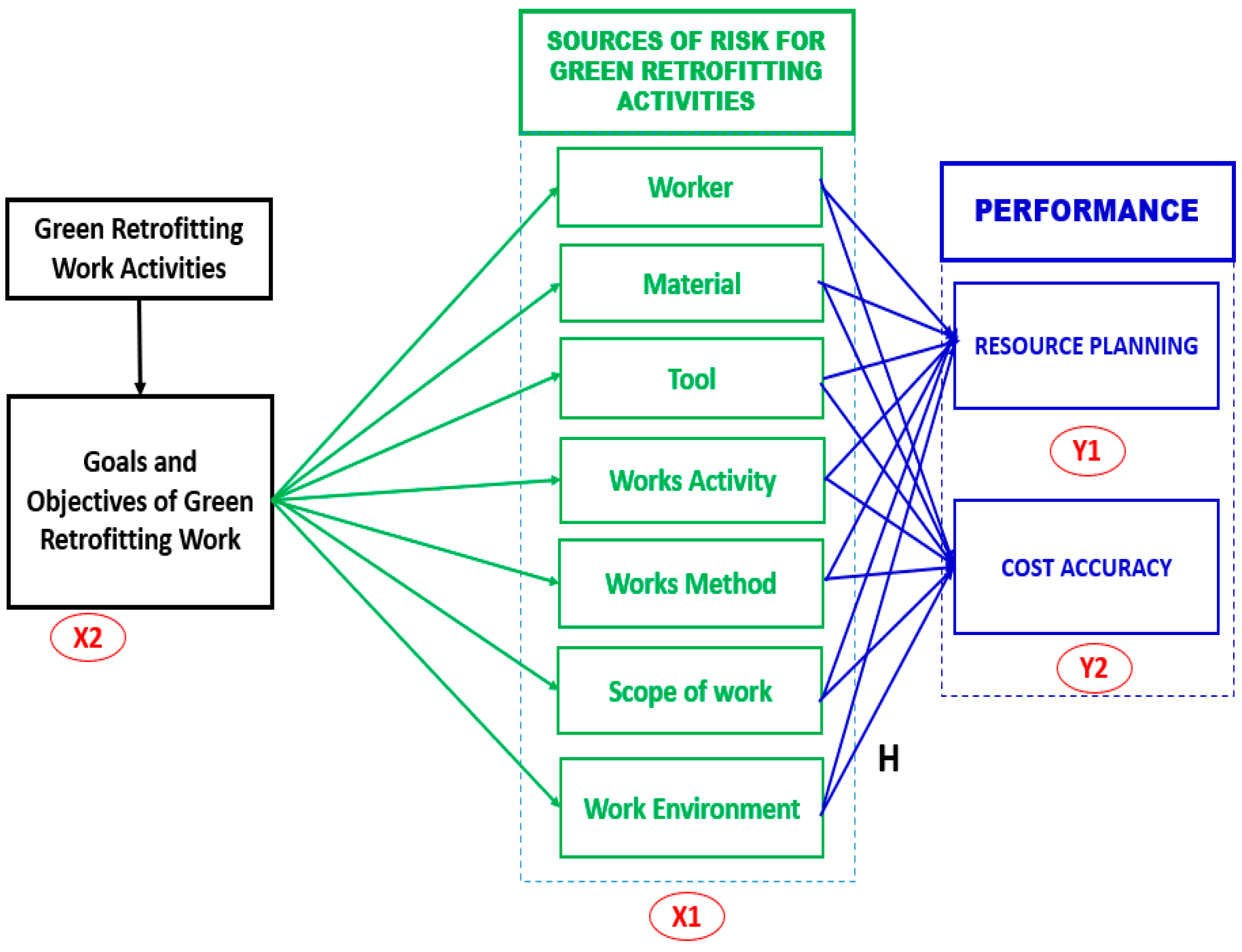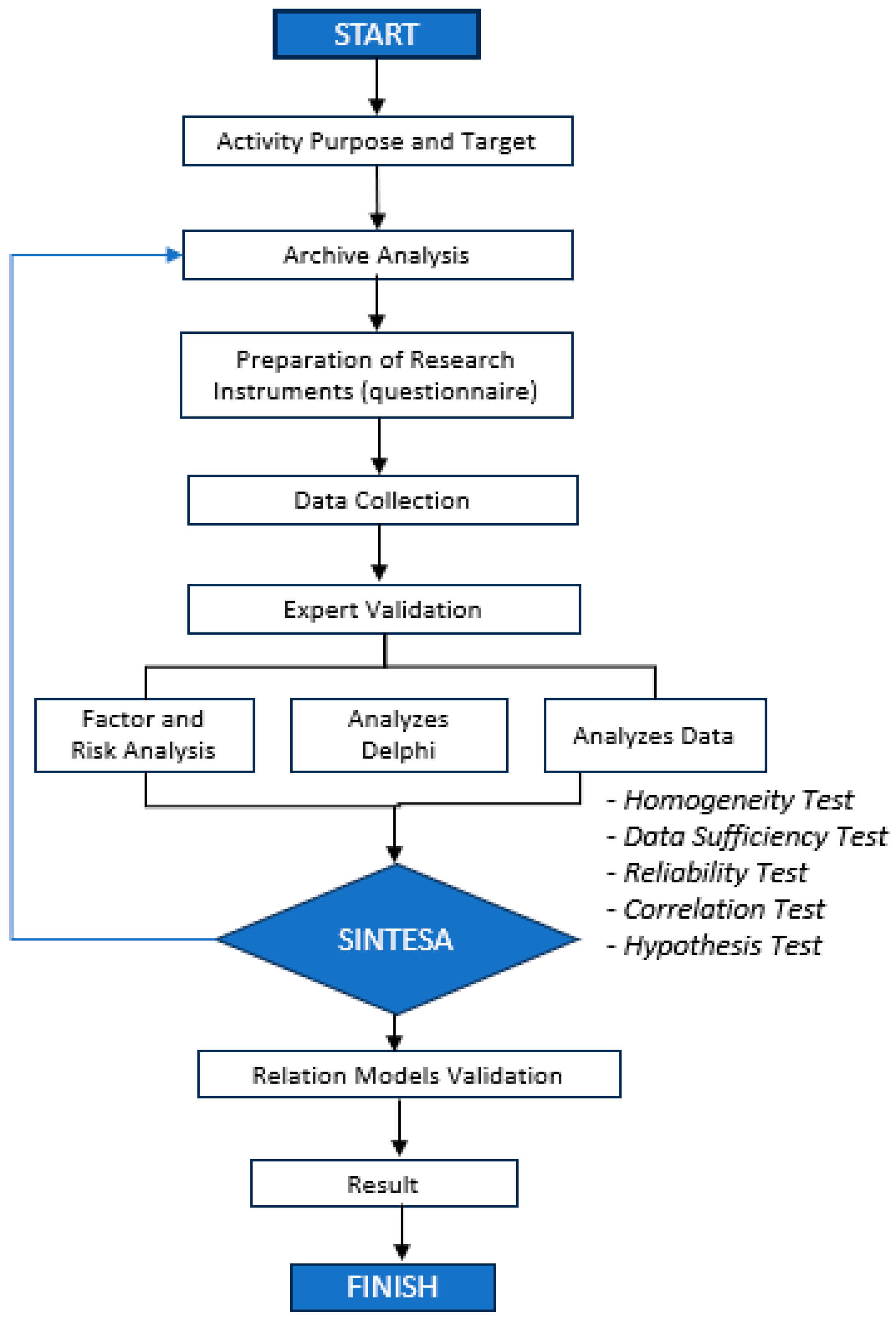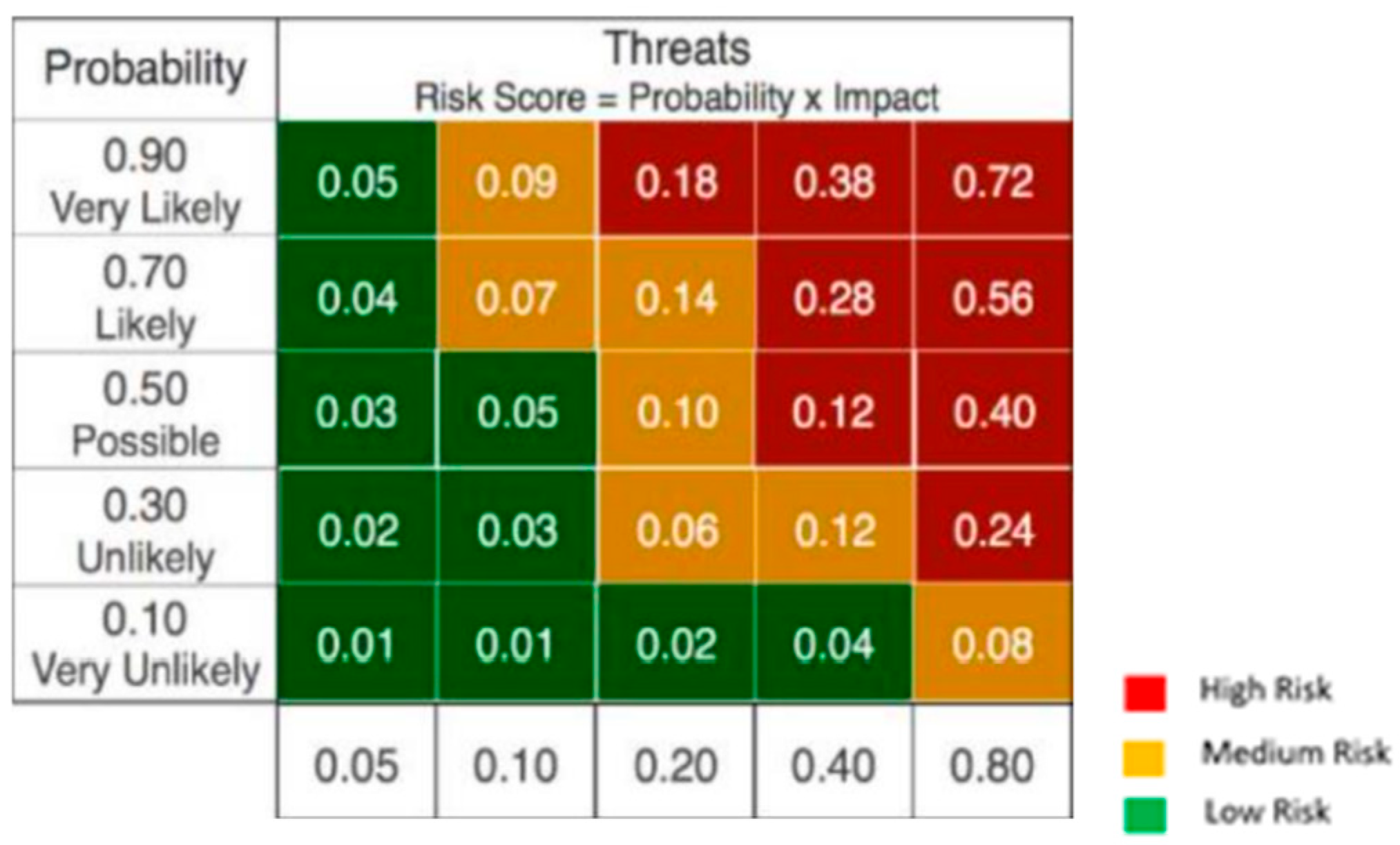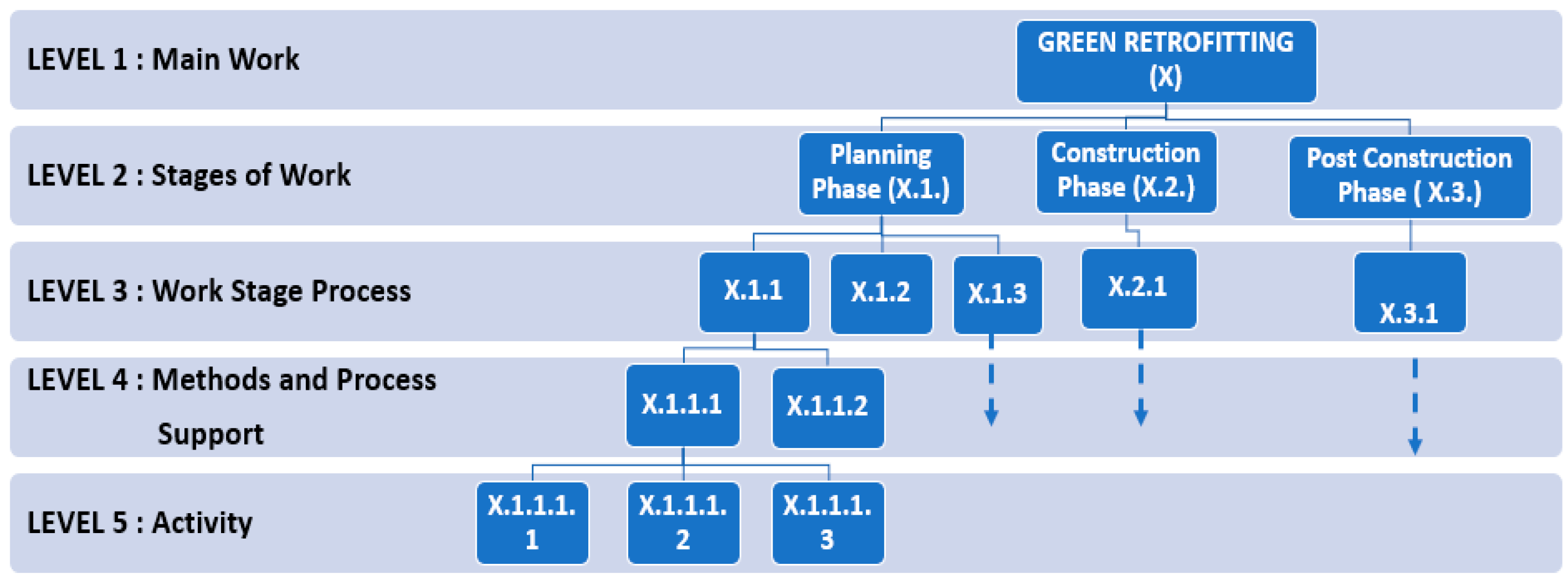The Risk of Implementing Green Retrofitting in High-Rise Buildings Based on Work Breakdown Structures to Improve Quality of Resource Planning and Cost Accuracy †
Abstract
1. Introduction
2. Literature Review
2.1. Retrofitting
2.2. Green Retrofitting Criteria and Benchmarks
2.3. Work Breakdown Structure (WBS)
- Activity is a component of the work performed during a project.
- Apportioned effort is an effort applied to work that is not easily divided into discrete efforts for direct proportions to be measurable
- Control account is an integrated control point of scope, budget, cost, and schedule management.
- Task is a task or job placed in a WBS for various jobs.
- The WBS component is input data in the structure to define project-related activities.
2.4. Risk Factors and Sources
2.5. Resource Planning
2.6. Cost Accuracy
3. Operational Model
4. Methodology
- Delphi technique, which is a consensus of project risk experts facilitated by a questionnaire to get an idea of the dominant project risk, which is then summarized and recirculated for further comment. This technique helps to reduce bias in the data [13].
- Interviewing, a technique for collecting data about project risks, which is carried out with project team members and other stakeholders who have experience in project risks.
- Root cause identification is a technique carried out to determine the essential causes of risk. The main result in the risk identification process is the existence of a risk register, which is divided into risk ratings.
- Data were collected using an online survey instrument developed specifically for this study. The survey comprised both closed-ended and open-ended questions. The closed-ended questions employed a Likert scale to measure participants’ perceptions of risk associated with green retrofitting projects, while the open-ended questions allowed participants to provide additional insights and comments.
5. Results and Discussion
5.1. WBS Level 5 (Activity) Relationship and Goals and Objectives
- Level 1, green retrofitting,
- Level 2, project cycle,
- Level 3, type of job,
- Level 4, process methods and support,
- Level 5, job activities.
5.2. Risk Relationship with Cost of Green Retrofitting Work High-Rise Building
5.3. WBS Risk Relationship with Green Retrofitting Work of High-Rise Building
6. Conclusions
- Project complexity is one of the main concerns that affect project success, both directly and indirectly. The main reason is that complex projects cause difficulties in identifying clear goals and targets. Therefore, it is important to re-evaluate priorities for effective project management. By setting the right priorities, the project team can focus on what matters most and allocate resources wisely so that the relationship between risk and resources is correlated and has a positive impact.
- The availability and demand for green materials in the market can cause price fluctuations that can have a positive impact on project cost estimates in the event of a decrease in green material prices, resulting in significant savings for project cost estimates. Material price fluctuations can also be a risk if material prices soar far above predetermined price estimates, so continuous monitoring of green material market conditions is very important to improve the accuracy of green retrofitting implementation cost estimation so that the relationship between risk and implementation cost estimation is correlated and has a positive impact.
Author Contributions
Funding
Institutional Review Board Statement
Informed Consent Statement
Data Availability Statement
Acknowledgments
Conflicts of Interest
References
- Kuriakose, J.; Jones, C.; Anderson, K.; McLachlan, C.; Broderick, J. What does the Paris climate change agreement mean for local policy? Downscaling the remaining global carbon budget to sub-national areas. Renew. Sustain. Energy Transit. 2022, 2, 100030. [Google Scholar]
- Tetteh, M.O.; Darko, A.; Chan AP, C.; Jafari, A.; Brilakis, I.; Chen, W.; Nani, G.; Kwame Yevu, S. Scientometric mapping of global research on green retrofitting of existing buildings (GREB): Pathway towards a holistic GREB framework. Energy Build. 2022, 277, 112532. [Google Scholar] [CrossRef]
- Jagarajan, R.; Abdullah Mohd Asmoni, M.N.; Mohammed, A.H.; Jaafar, M.N.; Lee Yim Mei, J.; Baba, M. Green retrofitting—A review of current status, implementations, and challenges. Renew. Sustain. Energy Rev. 2017, 67, 1360–1368. [Google Scholar] [CrossRef]
- Ma, G.; Liu, T.; Shang, S. Improving the climate adaptability of building green retrofitting in different regions: A weight correction system for Chinese national standard. Sustain. Cities Soc. 2021, 69, 102843. [Google Scholar] [CrossRef]
- Li, H.; Chen, B.; Feng, G. Investigation and Analysis of the Present Situation of Existing Building Green Retrofitting in Public Institutions. Procedia Eng. 2017, 205, 3340–3345. [Google Scholar] [CrossRef]
- Liu, G.; Li, X.; Tan, Y.; Zhang, G. Building green retrofit in China: Policies, barriers and recommendations. Energy Policy 2020, 139, 111356. [Google Scholar] [CrossRef]
- Hwang, B.G.; Zhao, X.; See, Y.L.; Zhong, Y. Addressing Risks in Green Retrofit Projects: The Case of Singapore. Proj. Manag. J. 2015, 46, 76–89. [Google Scholar] [CrossRef]
- IEA. Net Zero by 2050: A Roadmap for the Global Energy Sector. International Energy Agency, 224. 2021. Available online: https://www.iea.org/reports/net-zero-by-2050 (accessed on 1 June 2023).
- Zou, P.X.W.; Sanjayan, J.G.; Alam, M.; Wilson, J.L. Managing Risks in Complex Building Retrofit Projects for Energy and Water Efficiency; Department of Civil and Construction Engineering and Centre for Sustainable Infrastructure, Swinburne: Hawthorn, Australia, 2016. [Google Scholar]
- Nguyen, H.D.; Macchion, L. Exploring critical risk factors for Green Building projects in developing countries: The case of Vietnam. J. Clean. Prod. 2022, 381, 135138. [Google Scholar] [CrossRef]
- Hu, M.; Skibniewski, M.J. A Review of Building Construction Cost Research: Current Status, Gaps and Green Buildings. Green Build. Constr. Econ. 2021, 1–17. [Google Scholar] [CrossRef]
- Sugiharto, R. Analisis Faktor-Faktor Dominanmanajemen Risiko Terhadap Kinerja Keuangan Proyek Tahap Konstruksi. J. Teslink Tek. Sipil Dan Lingkung. 2020, 1, 1–11. [Google Scholar] [CrossRef]
- Nugraha, H.S. Pengelolaan Risiko dalam Proses Estimasi Biaya Tahap Desain pada Proyek Pembangunan Jalan Layang Non Tol di DKI Jakarta. Bachelor’s Thesis, Universitas Indonesia, Kota Depok, Indonesia, 2014. (In Indonesian). [Google Scholar]
- Tom, A. Encouraging the Growth of Sustainable Buildings in the Indian Commercial Sector Using Energy Performance Contracting. November 2016. Available online: https://www.researchgate.net/publication/319164738 (accessed on 20 December 2024).
- PUPR. Regulation of the Minister of Public Works and Public Housing Number 21 of 2021 Concerning Green Building Performance Assessment. Ministerial Regulation Number 21: PUPR Ministry Legal Bureau, Jakarta, Indonesia. 2022. Available online: https://jdih.pu.go.id/detail-dokumen/PermenPUPR-nomor-21-tahun-2021-Penetapan-Garis-Sempadan-Sungai-Pada-Ruas-Sungai-Ciliwung-Kabupaten-Bogor-KM-0-KM-10-Ruas-Sungai-Ciliwung-Kota-Bogor-KM-224-KM-37-Ruas-Sungai-Ciliwung-Kabupaten-Bogor-KM-37-KM-555-dan-Ruas-Sungai-Ciliwung-Kota-Depok-KM-555-KM-79-di-Wilayah-Sungai-Ciliwung-Cisadane (accessed on 25 April 2023).
- U.S. Green Building Council (USGBC), USGBC. LEED v4.1. 2022. Available online: www.usgbc.org/leed/v41 (accessed on 20 December 2024).
- GBCI. GREENSHIP Existing Building Certification Flow and Pricing. 29, 4. Divisi Rating Dan Teknologi Green Building Council Indonesia Juni 2016. Available online: https://www.gbcindonesia.org/files/resource/41209249-29c0-482a-ae95-7f34e0533e9a/RINGKASAN%20EB%201.1.pdf (accessed on 20 December 2024).
- Wahyuherma, R. Evaluasi Sistem Penilaian Existing Green Building di Indonesia dengan Metode Life Cycle Assesement untuk Merubah Existing Building Meraih Sertifikasi Hijau. Master’s Thesis, Universitas Indonesia, Kota Depok, Indonesia, 2017. [Google Scholar]
- Rose, K.H. A Guide to the Project Management Body of Knowledge (PMBOK® Guide)—Fifth Edition. Proj. Manag. J. 2013, 44, e1. [Google Scholar] [CrossRef]
- Sirait, D.A.M. Estimasi Biaya Kontigensi Proyek Green Building Berbasis Work Breakdown Structure. Bachelor’s Thesis, Universitas Indonesia, Kota Depok, Indonesia, 2017. [Google Scholar]
- Purba, H.H.; Purba, A.; Enrica, M.; Hardi Purba, H. Risks Leading to Cost Overrun in Construction Projects: A Systematic Literature Review. Adv. Res. Civ. Eng. 2021, 3, 43–60. [Google Scholar] [CrossRef]
- Afzal, F.; Yunfei, S.; Nazir, M.; Bhatti, S.M. A review of artificial intelligence-based risk assessment methods for capturing complexity-risk interdependencies: Cost overrun in construction projects. Int. J. Manag. Proj. Bus. 2021, 14, 300–328. [Google Scholar] [CrossRef]
- Canesi, R.; Gallo, B. Risk Assessment in Sustainable Infrastructure Development Projects: A Tool for Mitigating Cost Overruns. Land 2023, 13, 41. [Google Scholar] [CrossRef]
- Hidayah, D.N. Pengembangan Standar WBS Berbasis Risiko untuk Perencanaan Safety pada Pekerjaan Konstruksi Bendungan. Bachelor’s Thesis, Universitas Indonesia, Kota Depok, Indonesia, 2018. [Google Scholar]
- Purdy, G. ISO 31000:2009—Setting a New Standard for Risk Management. Risk Anal. 2010, 30, 881–886. [Google Scholar] [CrossRef]
- Anggraini, A.; Latief, Y. Development of work breakdown structure standard for safety planning on stadium construction work based on risk. J. Phys. Conf. Ser. 2021, 1858, 012073. [Google Scholar] [CrossRef]
- Cerezo-Narváez, A.; Pastor-Fernández, A.; Otero-Mateo, M.; Ballesteros-Pérez, P. Integration of cost and work breakdown structures in the management of construction projects. Appl. Sci. 2020, 10, 1386. [Google Scholar] [CrossRef]
- Mangare, J.B.; Sompie, B.F.; Tarore, H. Kajian proporsional model sumber daya pada proyek konstruksi gedung. J. Ilm. Media Eng. 2012, 2, 163–171, ISSN 2087-9334. [Google Scholar]
- Mufardis, B.; Oktaviani, C.Z.; Buraida, B. Proporsi Biaya Sumber Daya Manusia, Material Dan Alat Pada Proyek Konstruksi Jalan. J. Civ. Eng. Stud. 2021, 3, 127–133. [Google Scholar] [CrossRef]
- Ajizah, N. Perencanaan Sumber Daya Pada Pekerjaan Mekanikal Dan Elektrikal Bangunan Gedung Apartemen Berbasis WBS (Work Breakdown Structure). Bachelor’s Thesis, Universitas Indonesia, Kota Depok, Indonesia, 2018. [Google Scholar]
- Dandan, T.; Sweis, G.; Sukkari, L.; Sweis, R. Factors affecting the accuracy of cost estimate during various design stages. J. Eng. Des. Technol. 2019, 18, 787–819. [Google Scholar] [CrossRef]
- Serpell, A.F. Improving Conceptual Cost Estimating Performance. AACE Int. Trans. 2005, 12, ES131–ES136. [Google Scholar]
- PMI. A Guide to the Project Management Body of Knowledge; Project Management Institute: Newtown Square, PA, USA, 2013. [Google Scholar]
- Mintoharjo, A. Pengembangan Standar WBS (Work Breakdown Structure) Berbasis Risiko Pada Bangunan Utama Gedung Stadion Dengan Kontrak Terintegrasi Rancang Bangun Untuk Perencanaan Biaya dan Waktu. Master’s Thesis, Universitas Indonesia, Kota Depok, Indonesia, 2022. [Google Scholar]
- Hwang, B.G.; Zhu, L.; Wang, Y.; Cheong, X. Green Building Construction Projects in Singapore: Cost Premiums and Cost Performance. Proj. Manag. J. 2017, 48, 67–79. [Google Scholar] [CrossRef]
- Nasirzadeh, F.; Rostamnezhad, M.; Carmichael, D.; Khosravi, A.; Aisbett, B. Labour productivity in Australian building construction projects: A roadmap for improvement. Int. J. Constr. Manag. 2020, 22, 2079–2088. [Google Scholar] [CrossRef]
- Bevan, W.; Lu, S.; Sexton, M. Skills required to deliver energy efficient school retrofit buildings. Eng. Constr. Archit. Manag. 2020, 27, 3051–3073. [Google Scholar] [CrossRef]
- Yazid, R. Analisis Risiko Peningkatan (Cost Overrun) Pembangunan Terowongan Sudetan Kali Ciliwung ke Kanal Banjir Timur (KBT). Bachelor’s Thesis, Universitas Indonesia, Kota Depok, Indonesia, 2014. (In Indonesian). [Google Scholar]
- Nikman Lee, M.S.; Mohamed, S.; Nasid Masrom, M.A.; Abas, M.A.; Wee, S.T. Risk in Green Retrofits Projects: A Preliminary Study on Energy Efficiency. IOP Conf. Ser. Earth Environ. Sci. 2020, 549, 012084. [Google Scholar] [CrossRef]




| Index | Value | Probability |
|---|---|---|
| Very High | 5 (0.9) | Always happens |
| High | 4 (0.7) | Frequent |
| Middle | 3 (0.5) | Sometimes it happens |
| Low | 2 (0.3) | Rare |
| Very Low | 1 (0.1) | Very rare |
| Index | Value | Impact |
|---|---|---|
| Very High | 5 (0.8) | Very detrimental |
| High | 4 (0.4) | Big losses |
| Middle | 3 (0.2) | Quite detrimental |
| Low | 2 (0.1) | Small disadvantages |
| Very Low | 1 (0.1) | Negligible losses |
| Index | Value | References |
|---|---|---|
| Worker | Labor force does not have the skills to do work with special designs and features in the retrofitting process | [35] |
| Lack of knowledge about green retrofitting work | [36,37] | |
| Lack of standardized labor costs related to green building works | [37] | |
| Workers are not familiar with the green materials used | [38] | |
| Lack of experience supervising green retrofitting projects | [38] | |
| Unclear job specifications | [39] | |
| No training for workers | [25] | |
| Low worker productivity | [39] | |
| Lack of communication and coordination of work | [39] | |
| Insufficient number of staff | [37] | |
| Work Activities | Work sequences are not risk-based planned | [25] |
| Installation not by specifications or drawings | [25] | |
| Workmanship not by procedures | [25] | |
| There was a change in the work sequence | [25] | |
| Not identifying the level of artificial lighting in the space | [13] | |
| Not specifying areas that are air-conditioned or not | [13] | |
| Not taking into account natural lighting in OOTV lighting | [13] | |
| Not using the latest technology/inappropriate use | [13] | |
| Not knowing the conformity of the project with the RTRK | [13] | |
| Late award of client contract | [35] | |
| Lack of coordination at the design stage | [35] |
Disclaimer/Publisher’s Note: The statements, opinions and data contained in all publications are solely those of the individual author(s) and contributor(s) and not of MDPI and/or the editor(s). MDPI and/or the editor(s) disclaim responsibility for any injury to people or property resulting from any ideas, methods, instructions or products referred to in the content. |
© 2025 by the authors. Licensee MDPI, Basel, Switzerland. This article is an open access article distributed under the terms and conditions of the Creative Commons Attribution (CC BY) license (https://creativecommons.org/licenses/by/4.0/).
Share and Cite
Kussumardianadewi, B.D.; Latief, Y.; Rarasati, A.D.; Akhyari, M.A.; Faizurrahman, M. The Risk of Implementing Green Retrofitting in High-Rise Buildings Based on Work Breakdown Structures to Improve Quality of Resource Planning and Cost Accuracy. Eng. Proc. 2025, 84, 74. https://doi.org/10.3390/engproc2025084074
Kussumardianadewi BD, Latief Y, Rarasati AD, Akhyari MA, Faizurrahman M. The Risk of Implementing Green Retrofitting in High-Rise Buildings Based on Work Breakdown Structures to Improve Quality of Resource Planning and Cost Accuracy. Engineering Proceedings. 2025; 84(1):74. https://doi.org/10.3390/engproc2025084074
Chicago/Turabian StyleKussumardianadewi, Bernadette Detty, Yusuf Latief, Ayomi Dita Rarasati, Muhammad Arkan Akhyari, and Muhammad Faizurrahman. 2025. "The Risk of Implementing Green Retrofitting in High-Rise Buildings Based on Work Breakdown Structures to Improve Quality of Resource Planning and Cost Accuracy" Engineering Proceedings 84, no. 1: 74. https://doi.org/10.3390/engproc2025084074
APA StyleKussumardianadewi, B. D., Latief, Y., Rarasati, A. D., Akhyari, M. A., & Faizurrahman, M. (2025). The Risk of Implementing Green Retrofitting in High-Rise Buildings Based on Work Breakdown Structures to Improve Quality of Resource Planning and Cost Accuracy. Engineering Proceedings, 84(1), 74. https://doi.org/10.3390/engproc2025084074







